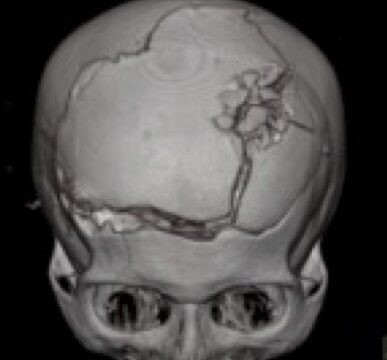For the first time, type, cause and outcome caused by penetrating objects recorded. Study of the Karl Landsteiner University of Health Sciences Krems.
Krems (Austria), 22. September 2022 – Nearly half of all patients who are admitted alive to hospital after traumatic brain injury involving objects penetrating the brain are able to survive. That’s one of the most surprising findings of a study by Karl Landsteiner University of Health Sciences Krems (KL Krems), the first in Austria to assess the nature, causes and recovery prospects of this type of injury. According to the study, it is important for treatment decisions to correctly assess the penetration velocity of the objects. Lower velocities cause injuries with significantly better healing prospects. In Austria, the frequency of injuries caused by bolt guns also stands out.
Objects (e.g., bullets, nails, bolts) penetrating the skull bone cause numerous different injuries to the brain, with healing prospects dependent on many variables. Nevertheless, few data exist to date on these types of injuries in the civilian sector. For Austria, a team from KL Krems now collected these data for the first time and published their conclusions internationally.
Life & Death
„In general, it must be said that penetrating brain injuries are fatal in many cases,“ explains Dr. Franz Marhold, Clinical Department of Neurosurgery at St. Pölten University Hospital, one of the teaching and research sites of KL Krems. „Three-quarters of those affected die while still at the scene of the accident, at least that’s true in the civilian sector.“ But even for those who are still admitted alive to a hospital, the chances of survival were previously considered low. But it is precisely for this group that the now-published study provides surprising insights.
„Our results show a more differentiated picture of the survival chances of these patients,“ explains Dr. Marhold. „According to the study, the decisive factor is, among other things, the speed of entry of the object causing the damage. If this is low, then 70% of those affected in our study had a prospect of a good prognosis. For objects with high velocity, however, it was less than 20%.“ At the same time, Dr. Marhold said, it is still not clearly defined what is considered „low“ speed and what is considered „high“ speed. But as the results of the study show, the distinction is important in deciding further treatment steps. And that, as he points out, in extremely time-critical situations in which the lives of those affected hang on knife-edge.
Long-Term Study
The data was collected over a period of 13 years at the St. Pölten University Hospital. During this time, a total of 24 affected patients were admitted alive and received further neurosurgical treatment. Significantly more than half of the affected patients (58%) self-inflicted their injuries. The method of choice was the use of a firearm. In most cases, this resulted in high-velocity injuries with a poor prognosis. „In these cases, brain damage also occurs beyond the actual entry channel of the projectile,“ Dr. Marhold explains. „Low-velocity objects, on the other hand, are more likely to cause localized injuries, which explains the much better prognosis of these victims.“
Injuries with low entry velocity were mostly accidents or suicide attempts. Here, the high proportion (5/13) caused by bolt guns, which are widely used in Austrian slaughterhouses, was striking. A number that is very high in international comparison.
In addition to the assessment via the speed of entry, the study shows that above all the pupil status of the affected persons provides important information on the possible success of treatment. If the pupils presented themselves as normal as possible, the study team was able to record a favorable course of treatment in more than 60%. However, if the pupils showed pathological reactions, this proportion dropped to below 20%. Assessment of consciousness and brain dysfunction according to the so-called Glasgow Coma Scale was also identified as an important decision criterion.
Overall, this study provides a first detailed insight of brain injuries with objects penetrating the brain in Austria. It reveals essential features for assessing the potential success of treatment in this acute emergency situation and is thus fully in line with the research focus of KL Krems, which comprises scientific findings with clinical added value for patients.
Original publication: Surviving the Scene in Civilian Penetrating Brain Injury: Injury Type, Cause and Outcome in a Consecutive Patient Series in Austria. F. Marhold, F. Scheichel, B. Ladisich, P. Pruckner, E. Strasser, M. Themesl, K. Ungersboeck & B. Popadic. DOI:10.3389/fsurg.2022.923949
About Karl Landsteiner University of Health Sciences (2022)
At Karl Landsteiner University of Health Sciences (KL) in Krems, the comprehensive approach to health and disease is a fundamental objective for research and teaching. With its Europe-wide recognized bachelor-master system, KL is a flexible educational institution that is tailored to the needs of students, the requirements of the labor market as well as the scientific challenges. Currently KL hosts about 600 students in the fields of medicine and psychology. The three university hospitals in Krems, St. Poelten and Tulln ensure clinical teaching and research at the highest quality level. In research, KL focuses on interdisciplinary fields with high relevance to health policy – including medical technology, molecular oncology, mental health and neuroscience, as well as water quality and related health aspects. KL was founded in 2013 and accredited by the Austrian Agency for Quality Assurance and Accreditation (AQ Austria). www.kl.ac.at/en
Scientific Contact
Dr. Franz Marhold
Department of Neurosurgery
University Hospital St. Pölten
Karl Landsteiner University of Health Sciences 3100 St. Pölten
T +43 2742 9004-12961
E franz.marhold@stpoelten.lknoe.at
W http://www.stpoelten.lknoe.at
Karl Landsteiner University of Health Sciences
Eva-Maria Gruber
Communications, PR & Marketing
Dr.-Karl-Dorrek-Straße 30
3500 Krems / Austria
T: +43 2732/720 90 – 231
M: +43 664 5056211
E: evamaria.gruber@kl.ac.at
W http://www.kl.ac.at/
Copy Editing & Distribution
PR&D – Public Relations for Research & Education
Dr. Barbara Bauder
Kollersteig 68
3400 Klosterneuburg / Austria
T +43 664 1576350
E bauder@prd.at
W http://www.prd.at/

